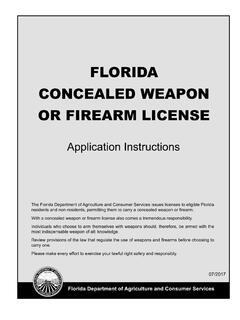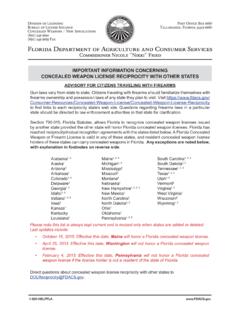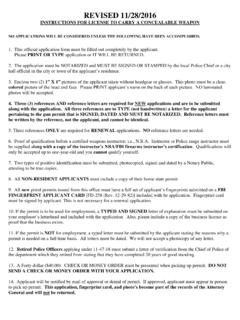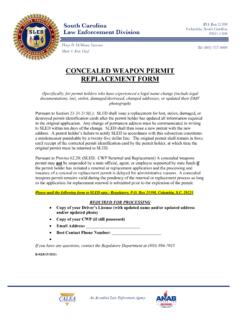Transcription of STRUCTURED SENTENCING IN NORTH CAROLINA
1 STRUCTURED SENTENCING IN NORTH CAROLINA . The Joint Appropriations Subcommittee on Justice and Public Safety February 11, 2015. NC SENTENCING and Policy Advisory Commission Box 2448. Raleigh, NC 27602. 919/890-1470. The Honorable W. Erwin Spainhour Susan Katzenelson Chairman Executive Director 1. PRINCIPLES OF. STRUCTURED SENTENCING . Truthful SENTENCING Policies Sentence length imposed by the judge should bear a close and consistent relationship to the sentence length actually served. Consistent and Certain SENTENCING Policies Offenders convicted of similar offenses, who have similar prior records, should generally receive similar sentences.
2 Rational SENTENCING Policies Sentence should be proportional to the severity of the crime as measured by the harm to the victim and the offender's prior record. Priorities Set for the Use of Correctional Resources Prisons and jails should be reserved for violent and repeat offenders, and community-based programs should be used for nonviolent offenders with little or no prior record. Balance Between SENTENCING Policies and Correctional Resources SENTENCING Policies should be supported by adequate prison, jail, and community resources. 2. THE OFFENSE CLASSIFICATION CRITERIA. The SENTENCING Commission was required by 164-41 to ".
3 Classify criminal offenses into felony and misdemeanor categories on the basis of their severity." The Commission developed classification criteria to guide the classification process and to ensure that there was a systematic and rational basis for the classifications. The Commission decided that the severity of an offense should be directly related to the harm to the victim that normally results or tends to result from the criminal conduct. The Commission defined three general types of harms: 1) harms to person (including both physical and mental injury); 2) harms to property; and 3) harms to society (violations of public order and welfare, violations of judicial or governmental operations, and/or violations of public morality).
4 Through considerable discussion and debate, the Commission grouped these harms into a ten-level hierarchy which served as the basis for the Commission's classifications (refer to the classification criteria on the following page). Once the classification criteria were established, the Commission reviewed the individual elements of all felonies in NORTH CAROLINA and assigned each felony to a specific offense class based on how closely the elements of the crime matched the classification criteria. The purpose of establishing the classification criteria was to create a rational and consistent philosophical basis for classifying offenses; to assure proportionality in severity; and to provide a guidepost for classifying new crimes in the future.
5 Under the classification criteria, the most serious offense classes (A through F) primarily involve personal injury, the risk of personal injury, serious societal injury or widespread societal injury. The lower offense levels (G through I) primarily involve property loss or less serious societal injury. The degree of harm is divided into three levels; injury to person, property or society; significant injury to person, property or society; and serious injury to person, property or society. The Commission also assigned misdemeanor offenses to three classes: class 1, class 2 or class 3.
6 The Commission did not create classification criteria for misdemeanors but relied on the maximum sentences previously set by the General Assembly. Generally, crimes which had previously been punishable by over six months were made class 1 misdemeanors, those previously punishable by more than 30 days and up to six months were made class 2. misdemeanors, and those previously punishable by 30 days or less were made class 3. misdemeanors. Assaultive misdemeanors were made Class A1 misdemeanors. 3. FELONY OFFENSE CLASSIFICATION CRITERIA*. CLASS CRITERIA. A ! Reserved for First Degree Murder [Reasonably tends to result or does result in]: B !
7 Serious debilitating long-term personal injury C ! Serious long-term personal injury ! Serious long-term or widespread societal injury D ! Serious infringements on property interest which also implicate physical safety concerns by use of a deadly weapon or an offense involving an occupied dwelling E ! Serious personal injury F ! Significant personal injury ! Serious societal injury G ! Serious property loss: Loss from the person or from the person's dwelling H ! Serious property loss: Loss from any structure designed to house or secure any activity or property Loss occasioned by the taking or removing of property Loss occasioned by breach of trust, formal or informal !
8 Personal injury ! Significant societal injury I ! Serious property loss: All other felonious property loss ! Societal injury M ! All other misdemeanors --------------------- * Personal injury includes both physical and mental injury. Societal injury includes violations of public morality, judicial or government operations, and/or public order and welfare. Note: The criteria were not used in the classification of the homicide offenses or drug offenses. 4. CLASSIFICATION OF A SAMPLE OF OFFENSES. (Effective 12/1/14). CLASS A FELONIES Maximum Punishment of Death or Life Without Parole First-Degree Murder.
9 (14-17). CLASS B1 FELONIES Maximum Punishment of Life Without Parole Second-Degree Murder. (14-17(b)) First-Degree Sexual Offense. ( ). First-Degree Rape. ( ). CLASS B2 FELONIES Maximum Punishment of 484a Months Second-Degree Murder. (14-17(b)(1) and (2)). CLASS C FELONIES Maximum Punishment of 231* Months Second-Degree Rape. ( ) First-Degree Kidnapping. (14-39). Second-Degree Sexual Offense. ( ) Embezzlement (amount involved $100,000 or more). (14-90). Assault W/D/W/I/K/I/S/I. (14-32(a)). CLASS D FELONIES Maximum Punishment of 204* Months Voluntary Manslaughter. (14-18) Child Abuse Inflicting Serious Physical Injury.
10 ( (a)). First-Degree Burglary. (14-51) Death by Vehicle. ( (a)(1)). First-Degree Arson. (14-58) Sell or Deliver a Controlled Substance to a Person Under 16 But Armed Robbery. (14-87) More than 13 Years of Age. (90-95(e)(5)). CLASS E FELONIES Maximum Punishment of 88* Months Intercourse and Sexual Offenses with Certain Victims Assault with a Firearm on a Law Enforcement Officer. ( ). (Substitute Parent/Custodian). ( ). Assault W/D/W/I/S/I. (14-32(b)) Second-Degree Kidnapping. (14-39). Assault W/D/W/I/K. (14-32(c)) Sell or Deliver a Controlled Substance Within 1,000 Feet of a Discharging Weapon Into Occupied Property.









